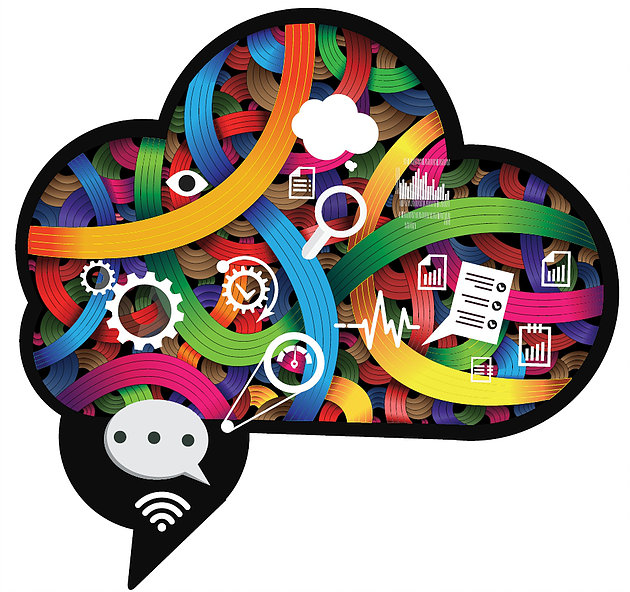
Published in PEOPLE + STRATEGY, The Professional Journal of HR People + Strategy
VOLUME 39 | ISSUE 4 | FALL 2016
Click here to download

Published in PEOPLE + STRATEGY, The Professional Journal of HR People + Strategy
VOLUME 39 | ISSUE 4 | FALL 2016
Click here to download

To be a successful leader, train your brain to slow down, prioritize, and read the environment.
LLG has an exciting new partnership to announce. We’re now blogging for Emergenetics International. Here’s our first post:
Leaders can enhance their ideal leadership styles by becoming more perceptive of the brain’s thought process and, as a result, better able to regulate it. Read about one leader below who could have benefited from this:
Isabelle sits in her office. She’s writing a report that’s due in 30 minutes. She watches the minutes tick by on her computer’s clock. The phone rings. Bob wants to crunch the quarterly numbers with her. His needs aren’t as pressing as her deadline, but this deserves her full attention. Bob launches in and promises to only take five minutes. She’s already put him off a few times, so she acquiesces. Just then, an email from her boss arrives, and she opens it. “Wait, what did you say, Bob?” As he repeats his explanation, Isabelle skims the email to assess if it’s relevant to her upcoming deadline – the one in 17 minutes that will affect her spending power next quarter.
She hangs up feeling slightly uneasy because she missed some details in their conversation. It’s not the kind of leadership she promotes and, feeling guilty, she convinces herself to think about it later. Thirteen minutes to deadline. Isabelle’s shoulders and stomach are tense. She realizes that she has skipped lunch. The ideas aren’t flowing; in fact, they’re harder to access. Her work-life balance is askew; she often feels overwhelmed by juggling her job, family needs and children’s schedules. Her eyes land on a postcard her sister sent from Aruba. She’s so tired. Will sheever get to lie on the beach?
Back to the report. Her analysis is part of what she and her boss will use to predict advertising spending for the next quarter. She knows she can’t fudge this – her division is larger than most and important to the bottom line.
Suddenly, Isabelle hears laughter and smells freshly popped popcorn coming from the kitchen down the hall. Usually, she is flexible and will join the office staff if she can. She enjoys their company, but not today. She flies out of her chair and races down the hall. She slams the kitchen door shut without speaking to anyone and storms back to her office.
Five minutes left. Can she pound out this report?
***
One of my favorite neuroscientists, Evian Gordon, PhD (University of Sydney Medical School and founding director of the Brain Dynamic Center), has developed the largest fully standardized international database on the human brain. He describes a universal and dynamic four-part thought process we all use called the 1-2-4 model. It looks like this:
The brain has one overarching organizing principle – to assess whether we’re safe or threatened at any moment. Our brains are biased against negativity, which affects our perceptions of others and vice versa. Think about how Isabelle reacted to her situation. She was unable to thoughtfully respond because she didn’t exercise clear boundaries for herself and her relationship to her environment. Her rude response will now have potentially large ramifications because she lacked the ability to prioritize and simplify. Moreover, she might be making decisions that are inaccurate, potentially affecting the health of the company.
We process information in two ways: non-conscious and conscious. Our brains scan the environment every one-fifth of one second to pick up on cues. The brain reacts to these cues without our conscious awareness. In Isabelle’s case, she started her day in a state of overwhelm. This set into motion a type of processing that put the brain on high alert and thinking at a disadvantage. Concentration and focus are affected, which made Isabelle hyper aware of her environment rather than the task at hand. She needed to analyze, assess and extrapolate in her report but wasn’t able to in her current state of mind. Ideally, we want to be aware of our surroundings, but not a victim to them.
Finally, there are four parts to the thinking process: Emotion (non-conscious), feeling, thinking, and self-regulation (conscious). In Isabelle’s example, once she became a victim to her environment she temporarily lost the ability to regulate her responses to it. Isabelle isn’t alone. Leaders like her often stumble with the challenges of everyday life. I see many leaders try to make quick decisions without taking the time to reflect. This type of pattern has a snowball effect and results in forgetfulness, lapses in concentration and self-modulation–none of which fall under the kind of leadership styles anyone wants to put forward. It impacts decision-making and has a trickle-down effect on business and relationships. In order to self-regulate with accuracy, leaders must learn to slow down, prioritize and become adept at reading their environment.
Thoughts and behavior weave together like a tapestry to create a picture people experience of us. (And remember, the brain holds onto negative thoughts longer than positive ones.) Leaders need to understand how their thought process interacts with their behavioral choices to create unintended messages. In fact, I would argue that it’s most important to focus on behavior because it’s all one has to indicate intention. I advise leaders to give behavior language such as, “I’m overwhelmed and need to shut my door in order to meet a deadline.” Or, “You all know how I save deadlines until the last minute, which can make me look a little nuts…” These simple statements give others a window into their actions and help avoid potentially damaging feelings. The goal is to use clear communication to adaptively manage emotion, feeling and thinking so that the prefrontal cortex can step in and effectively regulate actions.
Brain awareness is both profound and subtle because it’s personal. The same is true for the Emergenetics Profile, which I use with individuals and teams on a regular basis. I’ve found that like the 1-2-4 model, it integrates the understanding of thought and behavior, opening its subject to the nature of perception. As you use the Profile, think about it from this perspective – What does the Profile reveal about your unique potential? Where could you give language to your behavior so that people better understand your motivations? And what are your desired leadership styles? When done right, leadership is a life-long learning process andEmergenetics is a foundational tool that helps people deepen that journey.

The Significance and Science Behind Lifelong Learning
Too often, organizational training and even personality profiles box people into rigid categories. In my experience, this turns people off to learning because they’re given band-aids to meet short-term needs, but long-term development goals aren’t addressed. Such an approach feeds the notion that having a strong toolkit is the end goal. While this is easier than seeing learning as a lifelong process that evolves over time, it defeats the purpose of learning. The first step to developing a mindset of lifelong learning is to gain understanding of your self and then to look for ways to grow from the inside out. This is where leadership development starts and is the origin of good communication, which is exactly what the Emergenetics Profile reveals. And, that’s why I believe it is so powerful.
When it comes down to measuring how people think and behave, I choose the Emergenetics Profile time and time again. It sets the tone for learning in a positive and expansive way, unlike other profiling tools. After learning how to use the Profile, I’ve enjoyed watching people light up while gaining insight into themselves and others. It’s real treat to directly observe such growth.
In a recent post for Integrated People Solutions, I talked about Dr. Carol Dweck’s groundbreaking work on mindset. In this post, I’ll talk about the science behind Dr. Dweck’s work, how mindsets can evolve over time, and how the Emergenetics Profile supports that process.
There are two mindsets: growth and fixed. Someone with a growth mindset shows that intelligence and abilities grow over time. By embracing challenge and coupling that with a love of learning, the growth-mindset individual is also resilient. This kind of person finds sources of inspiration in the success of others, and seeks opportunities to apply that learning to their own growth. On the other hand, the fixed-mindset individual believes that his intelligence, skills and talent are fixed traits, there to make him look good. The focus is on looking smart and avoiding ridicule. This person develops a record of success rather than developing his talent, and his talent alone motivates his success.
What about the science? Can we actually see how mindset affects our brains? In a 2006 study, Mangels, Butterfield, Lamb, Good and Dweck studied EEG pattern differences in the brains of growth vs. fixed mindset participants. Study participants responded to difficult questions and then were given feedback about their answers. The researchers wanted to observe when their brains showed interested or attentiveness to the feedback they were given. It turns out that people with a fixed mindset became fixated when the feedback directly implicated their ability–they wanted to know if they were right or wrong. However, when the feedback turned to new information that could assist in their growth, their brains showed little interest.
Conversely, study participants with a growth mindset paid close attention to information that would help them grow and stretch their knowledge. Their priority was to learn. For me, this has vast implications for organizational development. When I’m working with individuals, I look for signs and ask questions to tease out whether someone has a growth mindset or a fixed mindset. It impacts one’s ability to use divergent thinking, problem solve, and develop creative insight so important to business success.
My Story of Change – A Fixed Mindset Sees the Light
One of the things I love about Dr. Dweck’s work is that there’s hope for all the fixed-mindset people out there. Although it’s true that having a growth mindset is more advantageous in life, those with fixed mindsets can “grow into” the growth mindset.
When I was young, I was more interested in looking good or being right than I was in progressive learning. Adulation propelled me forward. It was part of the environment I grew up in. This all changed when I moved to France and made that country my home for six years. Although not for everyone, one way to overcome ego (and a fixed mindset) is to live in a country that doesn’t care about what one has to say, unless it’s said in perfect French and without a foreign accent. Of course, I didn’t move there to overcome my ego. I was a university student keen on majoring in French. It seemed logical to live and breathe the culture I was studying, so I decided to finish my degree in France. Once the joy of arriving in France wore off, the learning process became painful.
My French was awful, and I often slunk to the back of the room to avoid being called on. It took six months to get up the courage to buy cheese from an actual person or to even talk to a professor. Until that point, I would purposefully go to Carrefour (the American equivalent of Costco) to watch people interact. I would buy what was on the shelves but avoid any exchange with salespeople. I didn’t want to open my mouth and sound hopelessly American. How embarrassing! My perspective changed when I finally started to understand the language and customs.
My teachers were unassuming and delightful children, ages four and six. As their au pair, they taught me the language by forcing me to read, play and interact. They fostered my inquisitive nature, which grew over time and now has developed into an ongoing thirst to put myself into uncomfortable situations that allow me to expand. Failure is no longer something that makes me freeze in my tracks. Rather, it’s just part of the growth process and something that I use to my advantage to overcome adversity. Today I run a start-up, and it’s overwhelming most of the time. However, if I focus my attention on how to learn what I don’t know and surround myself with people who can help educate me, I feel I succeed over time. My evolution is truly a lifelong process.
So, how might you work with the Emergenetics Profile to develop a growth mindset in yourself or others? One way I use the Profile is to look at it as the framework for a story. Sometimes, I ask people to tell me a story about themselves while keeping the Profile in mind. I ask for examples of their behavior because this encourages them to draw connections between their thinking and behavior. In turn, I watch behavior when they learn about their Profile and look for ways to explore insight. What do you think? Please write back and share your thoughts!

This blog post originally appeared at Integrated People Solutions.
Recently I worked with two corporate directors, Steve and Gary. Both hold senior level management positions, have worked for a similar number of years and have obtained impressive degrees from notable universities. Both work hard for their organization and attain solid results. However, a while back when the company started an organizational change mandate, an interesting thing happened. Gary’s behavior began to fall short of expectations. It impacted his team and their focus, productivity and attitude. For some reason, Steve didn’t show the same behavior traits, and neither did his team. Why?
It all comes down to mindset. Mindset impacts business relationships, and ultimately the success of an organization’s culture and the bottom line. Gary works hard to show his successes. He’s very good at outlining what needs to happen, but he’s not very interested in promoting his people or making them look good. He sees the world one way and it rarely changes. Steve, on the other hand, is a natural coach who believes that he shines when his people do well. He’s happy taking a backseat to them. He doesn’t tell people what to do and instead asks questions to lead them to the best conclusion. He understands that leaders often fall short because they don’t fully understand or see the ramifications of their decisions. He’s always looking for ways to develop their perspective.
Mindset is an idea about our intelligence and talent. People with a fixed mindset, like Gary, believe that traits are given or “fixed,” and that talent alone fosters success. On the other hand, people with a growth mindset, like Steve, believe that their basic abilities are simply a launching pad for growth and development. People with growth mindsets love to learn. And, more importantly, they show resilience, which is critical to success.
Carol Dweck, Ph.D., is a world-renowned researcher in the field of motivation at Stanford University, and she developed this concept. She says:
· Intellect and talent don’t guarantee success. They stand in its way.
· Praising doesn’t foster self-esteem and accomplishment. It jeopardizes them.
· Teaching a simple concept about the brain raises productivity.
Remember Enron? Did it fall apart because of mindset paralysis? It’s possible. Many companies are driven to hire talent, because it’s seen as the secret sauce that creates success for the organization. In Enron’s case, this strategy backfired because they became myopically focused on being talented and behaving in an extraordinary manner. As a result, their fixed mindset blinded them to collaboration, innovation and external market changes.
Cultures are made up of people, and overbearing and critical leaders are instrumental to creating a closed mindset among their team members. They can force their teams into fixed mentalities that prevent learning and growth. As a result, team members will worry about being judged and about what the boss thinks, rather than customers and the marketplace.
Let’s go back to Gary for a moment. Without realizing it, he’s being an overbearing leader. It’s his operating set point. This was harder to see prior to the change because he was working in an environment that he knew how to navigate and control; one that praised his successes. Moreover, he got away with never being wrong. Now he consistently operates outside his comfort zone. His constant need to be right, to govern and control how work is accomplished and his manipulation of messages to his boss all create undue stress for his people. In his case, one of his most talented business line managers only remained in her position for two years before resigning. No matter what she did to improve the organization, she was always made to be wrong. In addition, Gary comes to work every day feeling uncomfortable and trying to force everyone else to ease his pain by playing by his rules. His people feel intimidated into supporting him while at the same time pulled by the company’s new direction.
In studies, researchers have found that people with growth mindsets make better negotiators. They’re more easily able to push beyond obstacles and to reach win-win solutions. Moreover, managers with a growth mindset are more observant about their employees’ improvement. They don’t remain stuck in an impression that can limit them, and their employees see these managers as offering better coaching and employee development.
Managers with a growth mindset, like Steve, foster a culture of coaching which, in turn, creates opportunities for insight and innovation. Steve has been an ongoing client of mine for three years. We work together to offer growth strategies that open his employees’ minds to the possibilities they’re creating in their jobs. Not all of them will become leaders, but in Steve’s eyes all of them are leaders in their sphere of influence. He manages the most productive division of the organization, and his efforts to promote and build his people have made him a valued member of the executive team.
Gary remains a valued member of the organization, but he’s tested his relationships in the company. I was asked to work with Gary, and we’re focused on changing his mindset from one that is fixed to one that’s open. To do this, he is learning how skills, abilities and talent evolve throughout life. I want him to work to his talents and practice to his weaknesses. This focuses him on the process rather than the ultimate outcome of being the best all the time. We both believe he will succeed and, because the science says it’s possible to learn a new mindset, he’s optimistic. Stay tuned.
I have known Sophia Kristjansson for several years now. She is also one of Integrated People Solutions iPeople partners as well. Her recent blog post hits several solid points home that are common with many of the leaders we place through our executive search work here at Integrated People Solutions.

Post originally appeared at Emergenetics International.
I just returned from a week-long session with a group of HR leaders at which we discussed current trends in leadership development. One quickly percolated to the top – the mindful leader.
Mindful leadership is a phrase that gets thrown around to describe a leader-like characteristic organizational leaders want to see in others and also incorporate into their own lives. In general, HR leaders agree that organizations need leaders who are not only self aware, focused, strategic and creative, but who also are mindful of how they make decisions and interact with others. Relationships are key in today’s economy. So to help their employees grow, some of these companies practice mindfulness exercises as a part of their leadership development smorgasbord.
This fascinated me. While it’s well documented that mindfulness is generally beneficial, I wondered how these organizations wove a traditional Buddhist practice into their cultures. How was it affecting those who learned a meditative practice as well as those who didn’t choose it? Did employees feel it was mandatory? Who taught the classes? Did the teachers know how to help the students through tough patches? Of those who started a practice, who continued on?
These questions circled because I recently coached an executive who worked in an organization that practiced mindfulness exercises as an option for decreasing stress at work. He was so excited about what he was learning and how it made him feel that he decided to integrate a short meditation into the first 60 seconds of his team and division meetings. Bad call. Because of his status in the organization, people felt obligated to follow his lead and didn’t want to offend him. However, the practice wasn’t a fit with most of his colleagues who felt he should keep his mindfulness discovery to himself. He came close to losing the trust and respect of the people with whom he worked.
Five years ago I started a daily mindfulness practice. I generally enjoy its benefits, but at times I can’t concentrate because of external thoughts or physical discomfort. To be honest, sometimes I don’t want to sit and meditate for 20 minutes so I skip it. I do have a teacher who draws me back in for one reason – I feel less stressed when I meditate on a regular basis. With it I’m more centered, observational and creative. I know this is not very scientific, but I feel better. However, the process isn’t easy and takes focus, drive and commitment. This kind of choice isn’t for everyone; in fact, it’s very personal.
The HR leaders in my group pointed to current research showing that practicing mindfulness leads to more grey matter in the brain. In one particular study, “concentrations of grey matter increased in areas of the brain responsible for memory, learning, emotional regulation, self-referential processing and perspective.” Here’s another point: After an eight-week mindfulness practice, part of the brain’s flight, fight and freeze center, the amygdala, showed decreased density by imaging on the right side. As the amygdala shrinks, the prefrontal cortex, associated with awareness, concentration and decision making, becomes thicker. These relatively new findings seem to hold a lot of promise.
As the HR leaders talked, something else tugged at my thoughts: If someone practices mindfulness, develops better awareness and decreases stress, she’s able to better regulate her environment. After all, if she is more capable, she can work harder and longer. So, who really benefits from the mindful leadership training if it’s sponsored by an organization?
In that moment we were talking about the upsides of mindfulness, but a negative side could be perceived. Furthermore, I know from experience that many organizations like to take on programs without fully thinking through all the ramifications of their choice. The client situation I mentioned earlier in this post illustrates a possible negative outcome. I told the HR leaders that I’m not against the practice, I simply wanted them to realize any potential pitfalls in their desire to help their people. After all, they are uniquely placed to be stewards of organizational culture and leadership development.
Instead of using a traditional Buddhist approach to mindfulness in organizations, I suggest a secular approach that involves noticing the moment. I’ve been drawn more and more to Ellen Langer, Ph.D.’s work in mindlessness and mindfulness at Harvard University. Some have dubbed Dr. Langer the Mother of Mindfulness. She describes mindfulness “as the simple act of actively noticing things with a result of increased health, wellness and happiness.” She encourages people to focus on the present state. She’s never meditated in the Buddhist sense and she says that “eastern notions of meditation inspire post-meditative mindfulness, which is different from actively noticing in a present state.” Her unconventional studies illuminate what neuroscience pinpoints: “Our experience of everything is formed by the words and ideas we attach to them.”
Actively noticing things is quite specific and more powerful than simply saying that one wants to be present. What does “being present” really mean, especially to someone who is potentially unaware or mindless to the present moment? The act of noticing immerses us in the present state and allows us to observe something that will alter our perception of the experience. When I sit back and observe someone, I can either rely on my experience of that person or my judgment, which won’t get me anywhere new. If, on the other hand, I decide to look for three new things about that individual, my perception of the person evolves and grows. All of a sudden it opens a new world based in curiosity. This is awareness at its core.
Here’s what it comes down to: If you actively notice someone’s behavior, you’ll start to see things that weren’t perceptible before. By doing so, you may learn something new about that person that questions a belief or perception you had. That’s what the Emergenetics Profile sets people up for beautifully. By illuminating behavior on a sliding scale, you’re given a framework in which to operate. This is a simple way to practice what Dr. Langer describes as mindfulness—and, according to the research I mentioned above, get smarter in the process.